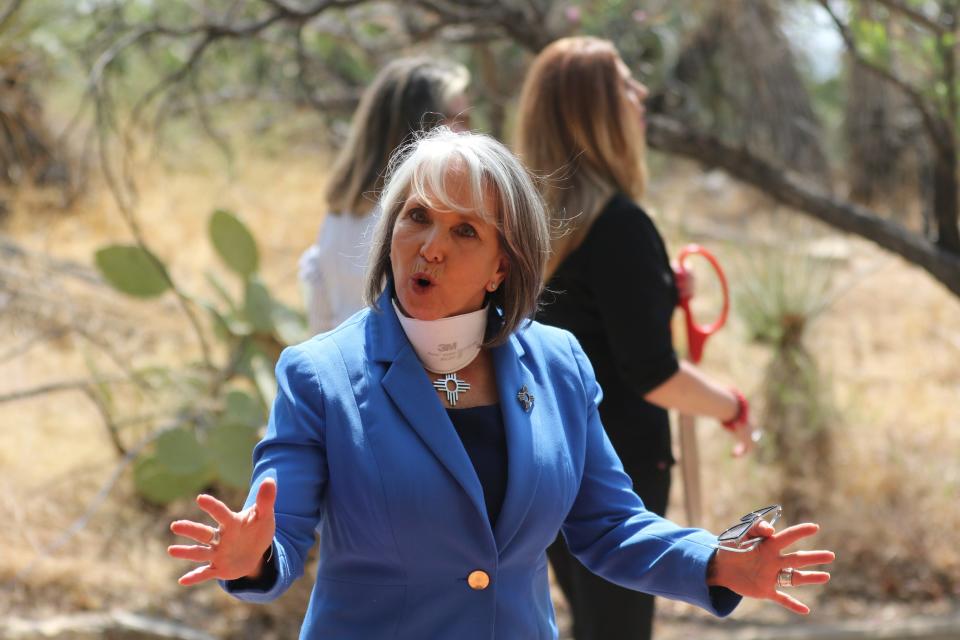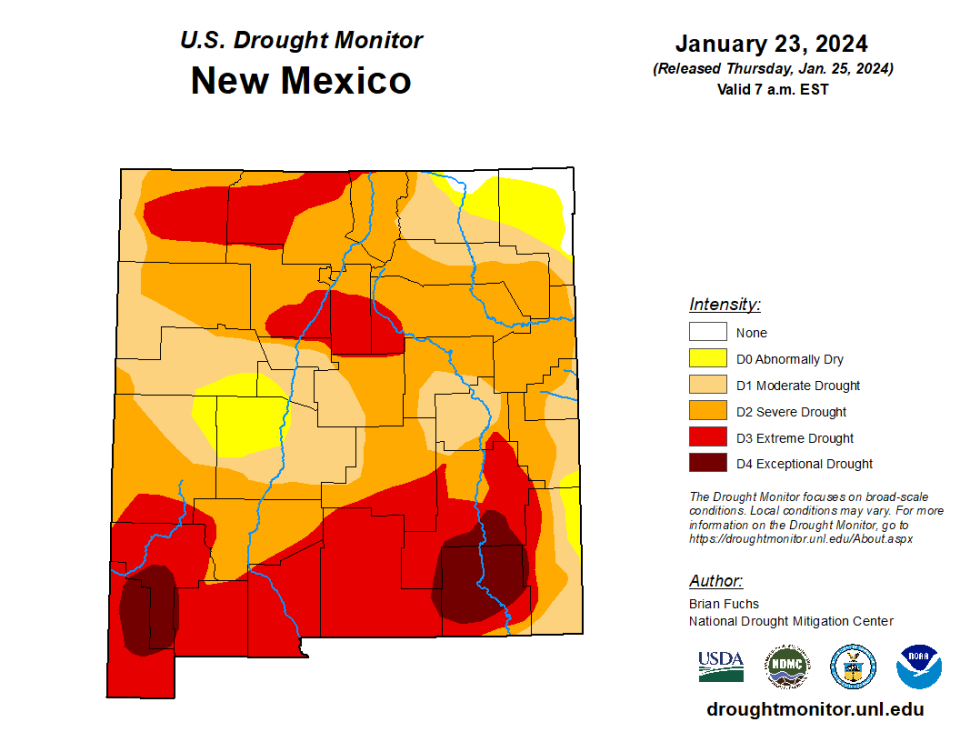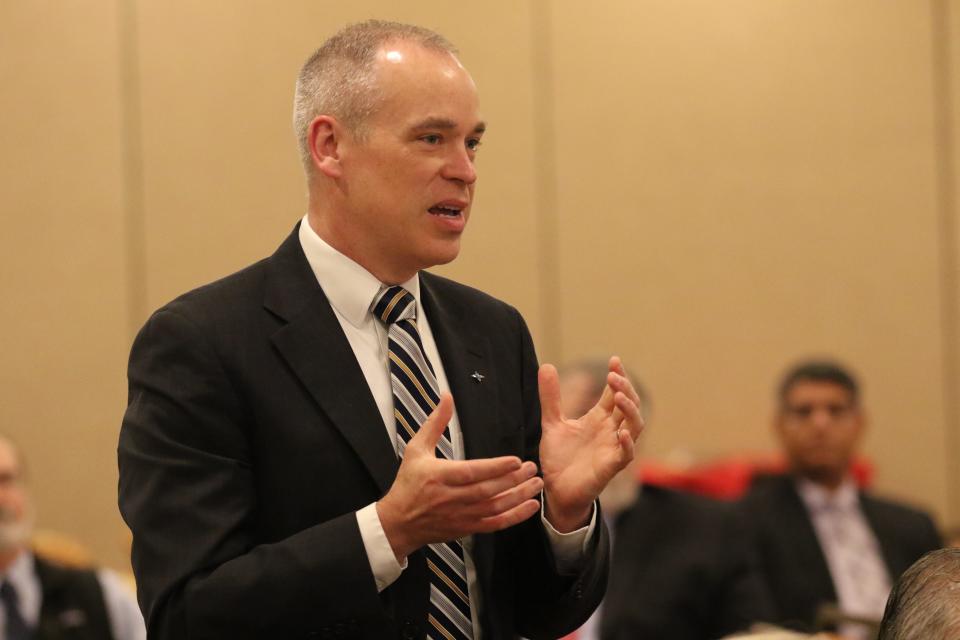New Mexico gov. unveils 50-year water plan that targets industry, agriculture
- Oops!Something went wrong.Please try again later.
New Mexico was expected to get hotter and dryer in the next five decades, and Gov. Michelle Lujan Grisham said the state must find new sources of water to prevent industries from drying up the state's freshwater supplies.
She announced Jan. 30 a 50-year water plan, developed over the past several years, that the governor said will better prepare the state for an expected loss of 25 percent of New Mexico's freshwater during that time frame.
The plan was presented at the end of January in a press conference at the State Capitol in Santa Fe where Lujan Grisham was surrounded by supportive cabinet members, lawmakers and local leaders.
More: NGL Energy Partners subsidiary expands water disposal pipeline in Permian Basin
It will include a water education plan aiming to reduce local consumption by 10 percent, incentives for new technology to cut agricultural use by 20 percent and establishing a program to collect statewide water loss data.

The plan also entailed a permitting program for surface water discharge, better regulating potential impacts to rivers, streams and lakes, and investments in forest management to reduce wildfire threats.
This came on the heels of a report issued in March 2022 by the New Mexico Bureau of Geology and Mineral Resources showing the state was likely to see an average temperature increase of 5 to 7 degrees Fahrenheit in the next 50 years.
More: Texas blocks oil and gas wastewater wells amid earthquakes. What is New Mexico doing?
The report was commissioned by the state to inform its efforts to develop the plan released this week.
Rainfall was not predicted to increase consistently, the report read, while snowpack and associated runoff were expected to decline by 2070, weakening stream flows.
Lujan Grisham said the plan would direct state agencies on conserving existing freshwater supplies, while also finding new sources like brackish water that could be used by industries in place of water fit for human consumption.
More: Lujan Grisham wants to use oilfield waste to solve drought. Is it an industry 'bail-out?'
“Over the long haul in the next 50 years, we’re going to have 25 percent less water. If we do nothing, where would you make 25 percent cuts?” Lujan Grisham said during the press conference. “We don’t have to make those draconian choices. We need to do a lot more conservation.”
New Mexico looking for new water sources to overcome drought
The governor earlier this year proposed a $500 million “Strategic Water Supply,” included in the plan, that would see the state buy treated wastewater from the oil and gas industry and others using bonds, and then provide the water to other industries.
More: Northern New Mexico Democrats propose fee increase, penalties on oil and gas companies
This was a means to reduce strain on the arid state’s dwindling water supplies but was met with opposition from the environmental community arguing such fluids would never be safe enough for use outside of extraction.
Lujan Grisham countered such concerns by arguing the treated brackish and wastewater would not be used as drinking water, but for water-intensive industries that do not provide for human consumption and were needed to diversify New Mexico's economy.
“We do have to bring to fruition water supplies that we don’t use. There’s nothing in this plan that would suggest that we are looking for new drinking water supplies,” she said. “We are asking industries including oil and gas to reuse their water and make it safe. Brackish water is a huge untapped supply.”
More: New Mexico starts 2024 in drought. Rains on the horizon, but will it be enough?
And it could prove needed as the state was struggling in a multi-year drought that appeared to be getting worse.
The U.S. Drought Monitor reported 98 percent of New Mexico was under some form of drought conditions, with about 35 percent of the state in “extreme drought” and 6 percent listed in “exceptional drought," as of Jan. 23.

That's worse than last year when only 4 percent of the state was in extreme, and less than a percent of New Mexico was in exceptional drought conditions, the monitor reported.
More: 'Fundamental disagreement' puts GOP and 'bureaucrats' in Santa Fe at odds for conservation
Lujan Grisham said better planning was needed to prepare New Mexico for this downward trend.
“It means we’re going to innovate and manage our water resources better,” she said.
New Mexico Environment Department Cabinet Secretary James Kenney said the plan will also direct his agency on how it will clean up contaminated water in New Mexico.
More: Gov. Lujan Grisham wants New Mexico to spend big. Should oil and gas foot the bill?
Kenney listed several sources of contamination in the state, including 14 superfund sites, 261 former uranium mining sites, more than 300 abandoned sites, and 944 underground tanks he said were leaking at gas stations.
The secretary also pointed to water contamination at federal facilities like Los Alamos National Laboratory and Air Force bases in the state.
He said part of the plan entailed New Mexico using satellite imagery to find leaks throughout the state that could pose risk to ground water supplies.
More: GOP fears swollen budget, as Democrats plan to spend big in New Mexico legislative session
“No amount of bad water is good water. We spend a lot of time on the quality of water. There is no shortage of work at the Environment department,” he said. “While we’re holding polluters accountable, we are also preserving the clean water that we do have, so we’re not having to clean it up at a later date.”

How will New Mexico pay for its water needs?
But that will take millions, maybe billions of state dollars in the coming years, and New Mexico Rep. Nathan Small (D-36), who serves as chair of the House Appropriations and Finance Committee said the budget bill recently passed by the committee for further lawmaker review was supportive of the governor’s water agenda.
He said that involved funding for a $100 million water trust, appropriations to the Interstate Stream Commission for water planning and to local communities for protection of existing sources for communities.
More: Do New Mexicans want solar? Lawmakers want to bet $110 million on local energy demand
Small agreed that the state should fund efforts to protect existing sources, but also find new sources for water users in New Mexico, an agenda he said could attract new businesses.
“We’re managing, we’re treating and protecting our watersheds,” he said. “We can utilize new sources and be welcoming to these large economic development projects.”
The governor was also joined by local leaders from Clovis, where the recently-formed Ogallala Land and Water Conservancy was working to find new sources of water for the eastern New Mexico plains, an area struggling with limitations to the Ogallala aquifer as its sole source.
This included new pipelines to bring water in from nearby reservoirs, said Clovis Mayor Mike Morris, who consulted with the state as part of its planning efforts and said the new plan would help support local communities like his own.
“Everyone is trying to do something. People say we’re going to need to think of something different, we’re going to have to make changes,” Morris said. “Our groundwater has been mined at a rate that is unsustainable. We need a second source.”
Adrian Hedden can be reached at 575-628-5516, achedden@currentargus.com or @AdrianHedden on the social media platform X.
This article originally appeared on Carlsbad Current-Argus: Lujan Grisham warns New Mexico faces worsening water losses

